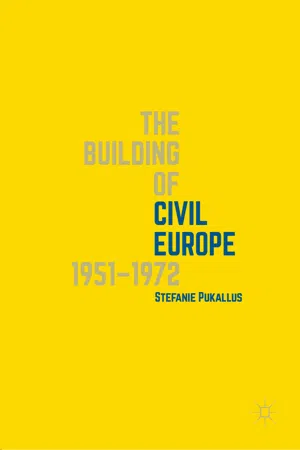The European Commission Officials
The historical evidence presented in this chapter and throughout the book means that it is impossible to dismiss two things: the importance of human agency in European integration and the fact that within the European Commission (and before that the High Authority ), 1 there existed a group of European Commission officials (henceforth Commission officials) who believed in the possibility and necessity of building a European Community that extended beyond the economic realm of market management and the political ambition of greater integration to include a uniquely civil dimension. 2
Specifically, they exhibited a genuine and systematic concern for what they perceived to be a neonate European general public and took it upon themselves to create the circumstances and conditions for this public to develop a degree of what one could broadly refer to as ‘European-ness’ and who would (so they believed) ultimately come to see themselves as European citizens . In other words, it was an extended version of Europe—one that went beyond economic and political harmony to include a conception of European identity , of being and feeling European, of European associative relationships conducted outside of the workplace or the assembly chamber. All of these Commission officials held, as a matter of course, some form of political and economic authority. 3 Correspondingly and because of this authority, they could exercise a form of leadership and decision-making which would contribute to what they regarded as a set of new European civil arrangements—arrangements that, by design, were meant to accord with their particular convictions and ideas about what they thought being a European citizen actually entailed. This ambition to create new civil arrangements was supported by their belief that pursuing a civil vision was perfectly compatible with what they regarded as the legitimate exercise of their authority.
The group of Commission officials pursuing these civil ambitions essentially consisted of a well-educated cosmopolitan elite who, in some form or another, supported and spoke up for a civil dimension to European integration. Some of them worked in front of the scenes and some worked behind the scenes. In front of the scenes they included the following well-known protagonists of European integration: Jean Monnet (1888–1979), 4 a French political economist and diplomat who didn’t belong to any party or Church and who before turning his attention to the building of Europe, worked in the United States and Great Britain and was part of the post-WWII French planners charged with the economic reconstruction of France . 5 Subsequently he was the leading figure behind the Schuman Plan and served as the first President of the High Authority . He resigned in 1955 and founded the Action Committee for the United States of Europe . René Mayer (1895–1972), 6 a French Jew who studied law and philosophy , occupied various ministerial positions in the French governments, joined the French Committee of national liberation defending the Algerian cause and went on to become the second President of the High Authority 1955–1957; Walter Hallstein (1901–1982), 7 a German lawyer and academic who participated in WWII as an officer in the German army deployed in France. He was captured in 1944 and spent the rest of WWII as a prisoner of war in the United States. After WWII he worked for the German chancellery on foreign affairs and was appointed head of the German delegation for the negotiation of the Schuman Plan. He was a vocal advocate of European federal integration and became the first President of the Commission 1958–1967; Jean Rey 8 (1902–1983), a Protestant Belgium liberal politician, 9 minister and diplomat with a doctorate in law who was Commissioner for External Relations 1958–1967 and President of the Commission 1967–1970 and who discovered his interest in and passion for foreign cultures and languages during his time at an English school; Albert Coppé (1911–1999), 10 a Belgium economist, journalist, academic and politician who wrote his doctoral thesis about the problems of the Belgium coal economy . He briefly became Ministre de la Reconstruction and then joined the High Authority as Vice-President in 1952 (until 1967) responsible for portfolios that included Markets , Transports, Press and Information, Investments, Coal, Production , Energy and Competition . In 1967 he was appointed Commissioner for Personnel and Administration, Press and Information, Statistics Office and relation with trade unions , from 1970 to 1973 he was Commissioner for Social Affairs, Transport , Budget and Press and Information. The group of Commission officials further included Robert Marjolin (1911–1986), 11 a French economist who married an American artist and who was Commissioner for Economic and Financial affairs and Vice-President of the Commission between 1958 and 1967; Franco Maria Malfatti (1927–1991), 12 an Italian Christian Democrat who held various ministerial positions before becoming the third President of the Commission 1970–1972—a position he left to return to national politics in Italy ; and Sicco Mansholt (1908–1995), 13 originally a Dutch farmer, who was part of the Dutch Labour Party and had also worked for his local ‘parti socialiste’, 14 entered national politics as Minister for Agriculture, Fishing and Food Supply directly after WWII and would serve first as Commissioner for Agriculture (1958–1972) and then briefly as President of the Commission (1972–1973). All of these Commission officials had, as Presidents of the Commission or Directors of specific units, a considerable amount of p...
